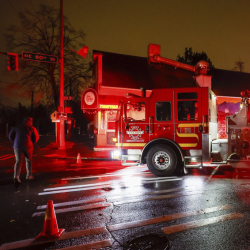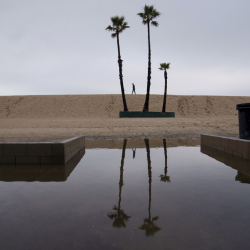BEIRUT (AP) -- Syria's army suspended days of punishing attacks on the restive city of Homs and began withdrawing its tanks Tuesday just as Arab League monitors visited the area, activists and officials said. Huge crowds poured into the streets shortly after the pullback, shouting defiantly that they will not be cowed by the crackdown.
Amateur video showed tens of thousands flooding the streets of the city, which had been under siege for days, to march in a funeral. They carried the open casket overhead with the exposed face of an older man with a white beard.
"Listen Bashar: If you fire bullets, grenades or shells at us, we will not be scared," one person shouted to the crowd through loudspeakers. Many were waving Syria's independence flag, which predates the 1963 ascendancy of President Bashar Assad's Baath party to power.
About 60 Arab League monitors - the first Syria's regime has allowed in during its nine-month crackdown on an anti-government uprising - began work Tuesday. They are there to ensure compliance with the League's plan to halt violence against mostly unarmed, peaceful protesters and the pullback in Homs was the first tangible sign Assad was implementing any of the terms.
After signing on to the plan early last week, Assad's regime had only intensified the violence, rather than easing up, and it was condemned internationally for flouting the agreement. Government troops killed hundreds in just the past week. On Monday, security forces killed at least 42 people, most of them in Homs.
Amateur video released by activists showed residents of Homs' tense Baba Amr district speaking to the Arab monitors.
"We are unarmed people who are dying," one resident shouts to an observer. Seconds later, shooting is heard from a distance as someone else screams: "We are being slaughtered here."
In another exchange, a resident tells a monitor: "You should say what you just told the head of the mission. You said you cannot cross to the other side of the street because of sniper fire."
The observer points to the head of the team and says: "He will make a statement." The resident the repeats his demand, and the monitor, smoking a cigarette, nods in approval.
The British-based activist group Syrian Observatory for Human Rights said as the monitors visited Homs, tens of thousands of protesters gathered in some neighborhoods to "reveal the crimes committed by the regime."
Later, the Observatory said some 70,000 protesters tried to enter the tightly secured Clock Square as security force fired tear gas and later live bullets to prevent them from reaching the city's largest square. The Local Coordination Committees, another activist group, said security forces were shooting at protesters trying to reach the central square.
The Arab League plan demands the government remove its security forces and heavy weapons from city streets, start talks with opposition leaders and allow human rights workers and journalists into the country. Before Tuesday's redeployment of at least some tanks, there had been no sign that Assad was implementing any of the terms, much less letting up on his brutal crackdown.
Homs, Syria's third largest city, has a population of 800,000 and is at the epicenter of the revolt against Assad. It is about 100 miles (160 kilometers) north of the capital, Damascus. Many Syrians refer to Homs as the "Capital of the Revolution."
Opposition activist Mohammed Saleh said the heavy bombardment of Homs since Friday stopped in the morning and tanks were seen pulling out. Another Homs-based activist said he saw armored vehicles leaving early on a highway leading to the city of Palmyra to the east. He asked that his name not be made public for fear of retribution.
"Today is calm, unlike pervious days," Saleh said. "The shelling went on for days, but yesterday was terrible."
The British-based Observatory said some army vehicles pulled out of Homs while other relocated in government compounds "where (they) can deploy again within five minutes."
A local official in Homs told The Associated Press that the team of monitors met with Ghassan Abdul-Aal, the governor of Homs province. After the meeting, the monitors headed to the tense districts of Baba Amr and Inshaat, which have witnessed the most intense crackdowns since Friday.
In Cairo, the head of the Arab League operations room Adnan Issa told reporters the team only visited Homs and met with Abdul-Aal. Asked if Syrian authorities were cooperating, Issa said: "We hope so. The mission will be sending us reports."
An official at the Arab League's operations room said the Sudanese head of the mission to Syria, Gen. Mohamed Ahmed Mustafa al-Dabi, was leading the team of at least 12 observers to Homs. The official spoke on condition of anonymity because he was not authorized to speak to journalists.
Given the intensified crackdown, the opposition sees Syria's agreement to the Arab League plan as a farce, and some even accuse the League of complicity in the killings. Since Syria signed on to the deal on Dec. 19, activists said nearly 300 civilians have been killed. About 150 more died in clashes between army defectors and troops - most of them defectors.
Syria's conflict is becoming increasingly militarized with army defectors mounting armed resistance.
Opponents of Assad doubt the Arab League can budge the autocratic leader at the head of one of the Middle East's most repressive regimes. Syria's top opposition leader Burhan Ghalioun called Sunday for the League to bring the U.N. Security Council into the effort. The U.N. says more than 5,000 people have been killed since March in the political violence.
On Tuesday, security forces shot dead two people in the Damascus suburb of Douma, one in the southern province of Daraa and one in the northwestern province of Idlib, according to the observatory. The LCC said 23 people were killed, including six in Homs.
Also in Homs, the local official said that before dawn, a bomb targeted a gas pipeline in the city, the third such attack within a month. The official, who spoke on condition of anonymity because he was not authorized to speak to the media, said the pipeline carries gas from fields east of Homs to a power station in the central province of Hama.
In another development, state-run news agency SANA reported that a student at Damascus University opened fire with a pistol inside a classroom at the medical department killing one student and wounding four. SANA did not give a reason behind the attack adding that security forces were searching for the student who fled.
The Observatory said the student who opened fire was a former anti-regime detainee who had been recently beaten by the pro-regime students, including the one he shot dead.
---
Bassem Mroue can be reached on http://twitter.com/bmroue
© 2011 The Associated Press. All rights reserved. This material may not be published, broadcast, rewritten or redistributed. Learn more about our Privacy Policy and Terms of Use.
Portland and Seattle
Free Subscription to Breaking News
Free Subscription to Breaking News



















































































































































































































































































































































